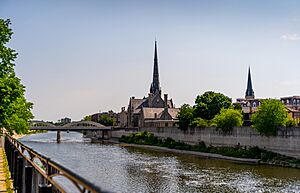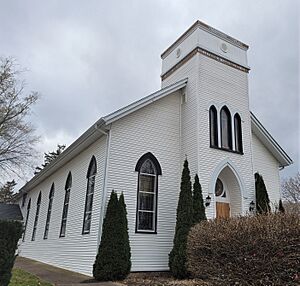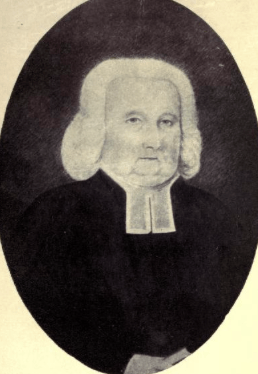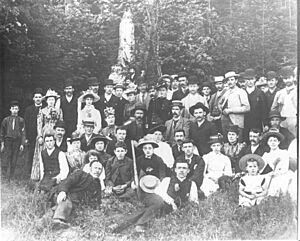Presbyterian Church in Canada facts for kids
Quick facts for kids Presbyterian Church in Canada |
|
|---|---|
| Église presbytérienne du Canada | |
 |
|
| Abbreviation | PCC |
| Classification | Protestant |
| Orientation | Mainline Calvinist |
| Polity | Presbyterian |
| Associations |
|
| Region |
|
| Origin | 1875 |
| Separations | 70% of the Presbyterian Church in Canada joined the United Church of Canada in 1925 |
| Congregations | 821 |
| Members | 79,961 (2019) |
| Ministers | 1,337 |
| (source, Acts and Proceedings 2007 p 713) | |
The Presbyterian Church in Canada (PCC; French: Église presbytérienne du Canada) is a Christian church group in Canada. It has been known by this name since 1875. For a time, from 1925 to 1939, another church, the United Church of Canada, also claimed the name. In 2021, about 301,400 Canadians identified as Presbyterian. This means about 0.8 percent of Canada's population.
The roots of the Presbyterian Church in Canada go back to Scottish settlers and French Huguenots. The first Presbyterian churches in Canada started in the late 1500s and early 1600s. They followed the ideas of European Protestant Reformation thinkers like John Calvin and John Knox.
The Presbyterian Church was once the largest Christian group in English-speaking Canada. In 1925, about 70 percent of its churches joined with the Methodist Church, Canada and the Congregational Union of Ontario and Quebec. They formed the United Church of Canada. Those who did not join the merger were called Continuing Presbyterians or Non-Concurring Presbyterians. They got the legal right to use the name "Presbyterian Church in Canada" again in 1939. The Supreme Court of Canada decided that the United Church had given up the name. This allowed the non-merging Presbyterians to use it. Important leaders like Lord Tweedsmuir and William Lyon Mackenzie King also supported them.
Contents
How the Church Began in Canada
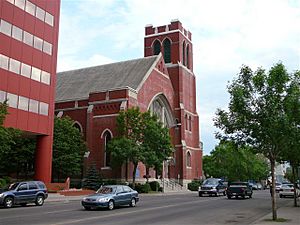
In 1759, Great Britain took control of New France during the Seven Years' War. A Scottish army group, the 78th Fraser Highlanders, had a Presbyterian chaplain named Reverend Robert MacPherson. This group helped start St. Andrew's Church in Quebec City.
In Nova Scotia, early Presbyterians were German settlers. They started St. Andrew's Church in Lunenburg in 1753. In Truro, Nova Scotia, First United Church (Presbyterian until 1925) was founded in 1760 by Scottish settlers. St. James Presbyterian Church was formed in 1925 by those who did not join the United Church. In Halifax, St. Matthew's started in 1749.
After the Thirteen Colonies left British North America, more people moved to Canada. This included Upper Canada (now Ontario) and Lower Canada (now Quebec). Many early Canadian Presbyterians were United Empire Loyalists of Scottish background. Others came directly from Scotland, like those on the ship The Hector in 1773.
Early church leaders came from Scotland, Ireland, and the United States. It was hard to form local church groups called Presbyteries at first. American influences came from Dutch Reformed missionaries and other Presbyterian groups.
Churches slowly formed in many communities. Sometimes, people waited 30 years for a minister. Families often held their own worship services and taught from catechisms.
Two wars caused American support for Canadian churches to stop. These were the War of 1812 and the Rebellions of 1837. The 1837 rebellions led to political changes.
Training Future Ministers
In 1811, Reverend Thomas McCulloch started Pictou Academy. This was the first school to train ministers in Canada. Some graduates went to Scotland for more training. This led to the creation of Dalhousie University later on. Another academy eventually became part of the Atlantic School of Theology.
In the Canadas, the United Presbytery of the Canadas formed in 1818. By 1839, this group joined with The Presbyterian Church of Canada in Connection with the Established Church of Scotland. This larger group had been set up in 1831.
In 1831, a Scottish church group agreed to send missionaries to the Canadas. A Canadian church group was formed in Toronto on Christmas Day 1834. They later started their own church in Toronto in 1838. They also opened a college for ministers in London in 1844.
In Toronto, a church group formed in 1820. In 1834, they became independent. In 1844, they joined with others to create Knox Presbyterian Church.
A college called Queen's College was started in Kingston in 1841. It is now part of Queen's University.
In 1844, a large group of ministers and students left the Church of Scotland. They formed a Free Church of Scotland Canadian Synod. Most students from Queen's College joined them. They went to Toronto and founded Knox College. This college later merged with another in 1861.
In the Maritime Provinces, different church groups were forming. The changes in the Church of Scotland in 1843 also affected Nova Scotia. Many ministers either went back to Scotland or joined the Free Church.
In 1860, the Presbyterian Church of the Lower Provinces was created. This was a merger of Free Church and United Presbyterian Church groups in Nova Scotia, Cape Breton, and Prince Edward Island. In 1866, groups from New Brunswick joined them.
In June 1861, the Canada Presbyterian Church was formed. This happened when the Free Church of Scotland and the United Presbyterian Church groups in Canada merged. This became the main Presbyterian group in Canada. It grew in cities, towns, and even into parts of the United States. It also expanded into the Canadian Northwest Territories.
The Canadian Presbyterian Church started a second college for ministers, The Presbyterian College, Montreal, in 1867. Both Knox College and The Presbyterian College, Montreal stayed with the Presbyterian Church in Canada after the Church Union in 1925.
In 1867, the Church of Scotland groups in the Maritimes merged. They became the Synod of the Presbyterian Church of the Maritime Provinces of British North America.
In 1869, the Canada Presbyterian Church added a new level to its structure. Its yearly meeting became a General Assembly. Four smaller, regional groups called synods were formed.
The first leader of the General Assembly, Reverend William Ormiston, suggested a meeting of all Presbyterian groups in Canada. This meeting happened in Montreal in September 1870. It led to a plan for these four groups to unite.
The Presbyterian Church in Canada: 1875 to 1925
On June 15, 1875, four Canadian Presbyterian churches joined together. They formed The Presbyterian Church in Canada in Montreal's Victoria Hall. These four groups were:
- The Canada Presbyterian Church (formed in June 1861);
- The Presbyterian Church of Canada in Connection with the Established Church of Scotland (formed in 1831);
- The Synod of the Presbyterian Church of the Maritime Provinces of British North America (formed in 1867); and
- The Presbyterian Church of the Lower Provinces (formed in 1866).
Some Church of Scotland churches did not join this union at first. But many of them eventually joined the PCC in the early 1900s.
As a united group, the PCC grew across Canada. It expanded into new areas where people were settling.
- The Synod of the Maritime Provinces (now called Atlantic) covered the areas of the two "Lower Provinces" groups.
- The Synod of Montreal and Ottawa replaced the old Montreal Synod. Its name changed to Quebec and Eastern Ontario in the 1950s.
- The Synod of Toronto and Kingston took in the old Toronto Synod. It also added a group from Montreal. This Synod now includes northeastern Ontario and Bermuda.
- The Synod of Hamilton and London merged two older groups. It was renamed the Synod of Southwestern Ontario in 1997.
Manitoba became a province in 1870. A church group was started in Kildonan in 1818. They waited 30 years for a minister, John Black. He was later joined by Reverend James Nisbet. James Robertson, a minister from Ontario, was called to a church in Winnipeg in 1873. In 1881, he became a missions superintendent. He helped new settlers and churches grow. Manitoba College started in Kildonan in 1871. It received support from Canadian churches before 1875.
With the building of the Canadian Pacific Railway, Western Canada developed quickly. By 1905, the provinces of Saskatchewan and Alberta were formed.
- The Synod of Manitoba and the Northwest was formed in 1884.
- The Synod of British Columbia was set up in 1890.
In 1905, when Alberta and Saskatchewan became provinces, separate synods were created for each:
- The Synod of Manitoba is now called Manitoba and Northwestern Ontario.
- The Synod of Saskatchewan covers that province.
- The Synod of Alberta (and the Northwest was added in 1990).
Leaders like King and Robertson passed away. Their successors then led the effort to unite with other Protestant churches. This led to the formation of the United Church of Canada on June 10, 1925. Most Methodist and Congregationalist Churches in Canada joined.
The Church After 1925
After many years of discussion, and delays because of World War I, voting on the Canadian Church Union happened in late 1924 and early 1925.
On June 9, 1925, the Presbyterian churches and groups that did not agree to join the United Church of Canada met. They gathered just before midnight at Knox Presbyterian Church (Toronto). About 79 leaders and others who were worried about their church's future came together. They were led by Reverend Dr. David George McQueen. He was a former leader (moderator) and a long-time minister in Edmonton. He led the group as they continued the General Assembly of the "continuing" Presbyterian Church. They later met at St. Andrew's Church (Toronto). These two churches in Toronto gave a lot of support to the Presbyterian Church Association in their fight against the union.
The name "continuing Presbyterians" was used until 1939. The United Church of Canada Act said that the "Presbyterian Church of Canada" had stopped existing. But the continuing Presbyterians kept using the name. The act was changed in 1939 to let them do so. About 30 percent of the former Presbyterians stayed separate from the United Church.
In Western Canada, many churches, groups, and missions were lost. All the colleges for ministers also joined the United Church.
- In Winnipeg, Manitoba College merged with another college in 1938. It is now part of the University of Winnipeg.
- In Vancouver, Westminster Hall merged with other colleges in 1927. It is now part of Vancouver School of Theology.
- In Edmonton, Alberta, Robertson College merged with another college after 1925. It is now called St Stephen's College.
- In Saskatoon, the Presbyterian College, Saskatoon became St. Andrew's College in 1925. These colleges later merged their administration in 2000.
After 1925, the church slowly rebuilt. This was made harder by the Great Depression and Second World War. After 1945, the church grew with new people moving to Canada. Many came from Presbyterian areas like Scotland and Ireland. Others came from the Netherlands, Hungary, Taiwan, Ghana, and Korea. Two separate Korean Presbyterian groups were set up in 1997.
Global Connections
The Presbyterian Church in Canada has a presence around the world. For example, St Andrew's in Hamilton, Bermuda has been connected to Canadian churches since 1842. Many churches in Canada have members from different nations and cultures.
The church sends missionaries or works with international partners. Before 1875, people from Atlantic Canada went to places like Vanuatu in the South Pacific and Trinidad.
In 1871, the Canada Presbyterian Church sent George Leslie MacKay to Formosa (now Taiwan). This connection continues today with the Presbyterian Church in Taiwan. Other missionaries went to China, India, Korea, and Japan.
After the Church Union in 1925, some changes happened. Later, wars and political changes in Asia caused missionaries to leave some areas.
Since 1954, Nigeria has been a place for PCC service in Africa. Mary Slessor had worked there before with a Scottish Church. Other African nations like Malawi, Ghana, Kenya, and Mozambique have also partnered with the PCC. The church also serves in Central America and Eastern Europe.
Working with Other Churches
The Presbyterian Church in Canada has also worked with other Christian churches. The World Communion of Reformed Churches was formed in 1875. Canadians were very involved and hosted meetings in Toronto, Montreal, and Ottawa.
The Presbyterian Church in Canada was a founding member of both the Canadian Council of Churches (1944) and the World Council of Churches (1948).
Since 1939, relations with the United Church of Canada have gotten better. They work together on many projects locally, nationally, and internationally. Many churches hold joint services during the summer. They also work together on events like the Week of Prayer for Christian Unity and local outreach programs like food banks.
How the Church is Organized
The Presbyterian Church in Canada currently has about 1000 churches across the country. Most of these churches are in Southern Ontario. This is because of early settlement and people moving to cities after World War II. Also, many people in this area did not join the 1925 church union.
The General Assembly is held every year in early June. It has recently been held in different cities in Southern Ontario and Quebec. The number of people who attend is based on the number of ministers and elders from each church. Young adults and students from colleges for ministers also attend.
Every ten years, the General Assembly tries to meet in other parts of Canada. For example, it met in Edmonton in 2005, Charlottetown in 1996, and Vancouver in 1957 and 1989. In June 2010, it was held in Sydney, Nova Scotia.
The church has churches, missions, and preaching points in every Canadian province. It also has St Andrew's Church in Hamilton, Bermuda.
How the Church Communicates
Communication has always been important for the Presbyterian Church in Canada. Before 1875, every group had its own newspaper or journal.
In January 1876, the Presbyterian Record started. It combined older church newspapers. It was published monthly until 2016. Then, it was replaced by The Presbyterian Connection, a quarterly newspaper, and PCConnect, a monthly email newsletter.
Other publications include Glad Tidings and the Presbyterian Message, which are from women's missionary groups. Presbyterian History has been published regularly since 1957.
See also
- Protestantism in Canada
- Christianity in Canada
- Religion in Canada


